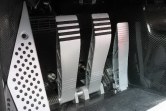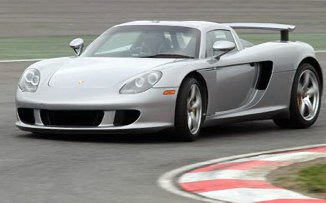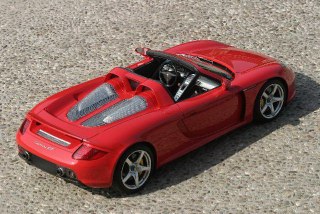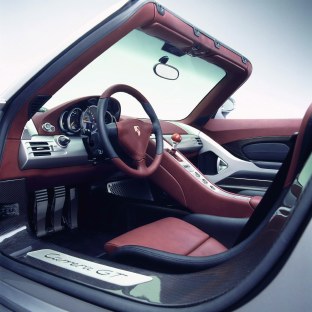CarTest! Expert car reviews and advice | home
CarTest! Expert car reviews and advice | CarTest Contents | New Car Reviews | Used Car Reviews | What is your car worth? | Automotive NewsBriefs | Award-Winning Models | Find the Best Vehicle | Automotive Advice | Save on Gas | Driving Tips & Maintenance Advice | Safety Research & Insurance Tips | Tire Advice | Road Trips | Auto Racing | Classics & Collectibles | Newsletter | About Us | SEARCH CarTest!

Aluminum foot pedals in the Porsche GT are part of the sports-car icon design.
2005 Porsche Carrera GT Road Test
A street-legal engineering showcase
By Bill Roebuck

I recently had the drive of a lifetime at Mosport International Raceway near Bowmanville, Ont., when Porsche Cars Canada brought two all-new 600-hp 2005 Carrera GTs to for a day of testing on the track and on roads around the area.
"The GT is a rolling showcase for Porsche engineering expertise," says Bob Carlson, a spokesman for Porsche Cars North America. "It has 70 new patents and many developments which will be incorporated into future Porsche models."
The Carrera GT is a low, sleek, lightweight roadster. It's turned into a convertible by removing the roof panels and storing them in the front trunk space. The chassis and suspension are based on the architecture of the Porsche GT1, the car that won the 24 Hours of Le Mans race in 1998.
 The star of this car is its 5.7-litre, 605-hp V-10 engine that can power it from a standing start to 100 km/h in just 3.9 seconds. Keep shifting the gears up with the tight six-speed manual transmission and you'll reach a very illegal 160 km/h in less than seven seconds.
The star of this car is its 5.7-litre, 605-hp V-10 engine that can power it from a standing start to 100 km/h in just 3.9 seconds. Keep shifting the gears up with the tight six-speed manual transmission and you'll reach a very illegal 160 km/h in less than seven seconds. There's plenty of torque in all gears (it's rated at 435 lb.-ft. at 5,750 rpm). During the drive around local villages and highways, I found you could leave the GT in fifth and drive it comfortably at most speeds. But there's not much fun in that, is there?
The GT's rated top test-track speed is 330 km/h. After a couple of laps, you'll be believing you could go up against Michael Schumacher's Ferrari in a Formula One race. After all, that's the kind of speeds he drives at, albeit with 900 hp behind him.
The GT's engine is behind the driver. Lift the rear hood and you'll see an incredibly neat and tidy engineering marvel. There's no random wires or hoses protruding anywhere. Everything messy is hidden or covered. A pair of huge air intake pipes flanks the engine bay in a compartment that itself is a work of art.
Up front, a slim trunk will hold enough for a weekend getaway, if you pack carefully and don't stow the roof panels. Forget about the golf clubs, though, unless you put them in the passenger seat. But you'll probably pack your outfit in the standard Porsche luggage that's been specially designed to fit the contours of the GT's stingy storage space. Each five-piece set matches the car's interior colour.
 It's hardly worth mentioning, but the cargo capacity is a measly 76 litres. Even the tiny Smart from Mercedes-Benz has three times more capacity. All five pieces of the special Porsche GT luggage fit into various nooks and crannies.
It's hardly worth mentioning, but the cargo capacity is a measly 76 litres. Even the tiny Smart from Mercedes-Benz has three times more capacity. All five pieces of the special Porsche GT luggage fit into various nooks and crannies.Storage options are at such a premium that the engineers even designed a pair of hidden ones in the doors. They're large enough to fit in your fist up to your wrist, but you can only access them when the doors are open, so what you'd store there is up to your imagination. And don't even think about cupholders!
The interior is cleanly and beautifully designed, with flowing surfaces dominated by smooth carbon fibre, magnesium and leather materials. The shift lever is a ball-shaped knob made of lightweight birch and ash that is meant to remind drivers of the balsa wood knob in the  1970 Le Mans-winning Porsche 917.
1970 Le Mans-winning Porsche 917.
 1970 Le Mans-winning Porsche 917.
1970 Le Mans-winning Porsche 917.This really is a street-legal racecar. But it's surprisingly comfortable and easy to drive on regular roads ... except for the touchy clutch, which operates more like a light switch -- it's either on or off. It engages fast and hard, so smooth getaways require lots of patience and practice.
On the track, the Carrera GT is stable and secure, building your confidence with each lap. I never felt I'd get in trouble with the GT at Mosport, even more than 220 km/h. The tach redlines at 8,400 rpm.
Much of the design focuses on airflow. There are large intakes and outlets in front of and behind the doors to provide airflow to and from the engine. They're also designed to enhance its road-hugging abilities.
Stainless steel 'power domes' that stretch back from the rear panel behind the GT's seats are cross-drilled to enhance cooling and also provide a view of the engine from above.
The rear of the car features a large, retractable wing. After a few hot laps around the track, the wing -- which normally rises at 120 km/h and lowers at 80 -- automatically remained raised to vent heat until the engine cooled sufficiently.
The wing, which rises 160 mm, aids stability at high speeds by increasing downforce as much as 30%.
Airflow ducts also are located underneath the car. They help channel air to maintain the car's 30% front, 70% rear downforce balance.
Much of the GT is made of carbon-fibre reinforced plastics, just like on Formula One models. Carbon fibre is light, yet strong and stiff. The bumpers, however, are regular automotive composite with aluminum crossbars.
Porsche developed a special paint to cover the carbon-fibre body. It won't fade over time or allow the carbon fibre weave to show through.
The chassis is a racing-style monocoque design, made from a small number of elements that are bonded together in a high-pressure furnace to form a single or mono structure. It provides the rigidity for the car. The carbon-fibre body panels are stuck on like decorations, and are not part of the vehicle's support structure, another feature borrowed from high-speed racecars.
The Carrera GT is the first road car built around such a chassis and also is the first with an engine and transmission support made entirely of carbon fibre material. It was devised by Porsche researchers because of the material's structural strength and thermal resistance.
Other innovations in the GT are the use of a ceramic composite clutch, the first ever in a Porsche. The ceramic material allows for an extremely compact design and contributes to the car's low centre of gravity. Porsche engineers created a new, two-plate dry clutch with carbon fibre and silicon carbide materials that are strong, light and provide an exceptional service life.
The brakes on the GT also are ceramic composite. Even though they are large and thick, the discs are 50 percent lighter than comparable cast iron versions. Like all Porsches I have driven, the brakes are superb. As with anything that goes fast so quickly, you especially want the reverse to be true.
Interested? Get your order in quick if you have a celebrity-size wallet (they cost $440,000 US -- the Canadian price is based on the exchange rate on the day of the transaction, so figure around $600,000).
Jerry Sienfeld and Tim Allen already have theirs, and Jay Leno had his shipped from the factory in Leipzig, Germany, in September.
Only 500 Carrera GTs a year will be built between 2004 and 2006 (at the rate of two a day) for a total of 1,500. Each model has a number plate on the dashboard. As much as half of the production will be delivered to North America, and Canada is allotted 5% -- fewer than 40 cars.
According to Porsche spokesman Michael Baumann, once they're gone, they're gone. "There'll be no number fifteen-o-one."
© Copyright Bill Roebuck, CarTest.ca 2005. Posted July 14, 2004.
Search CarTest!

Custom Search